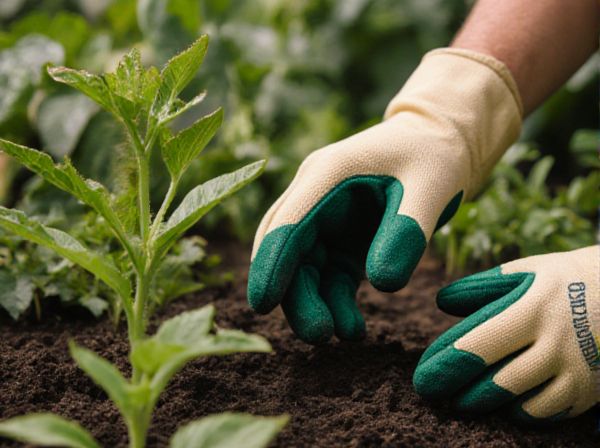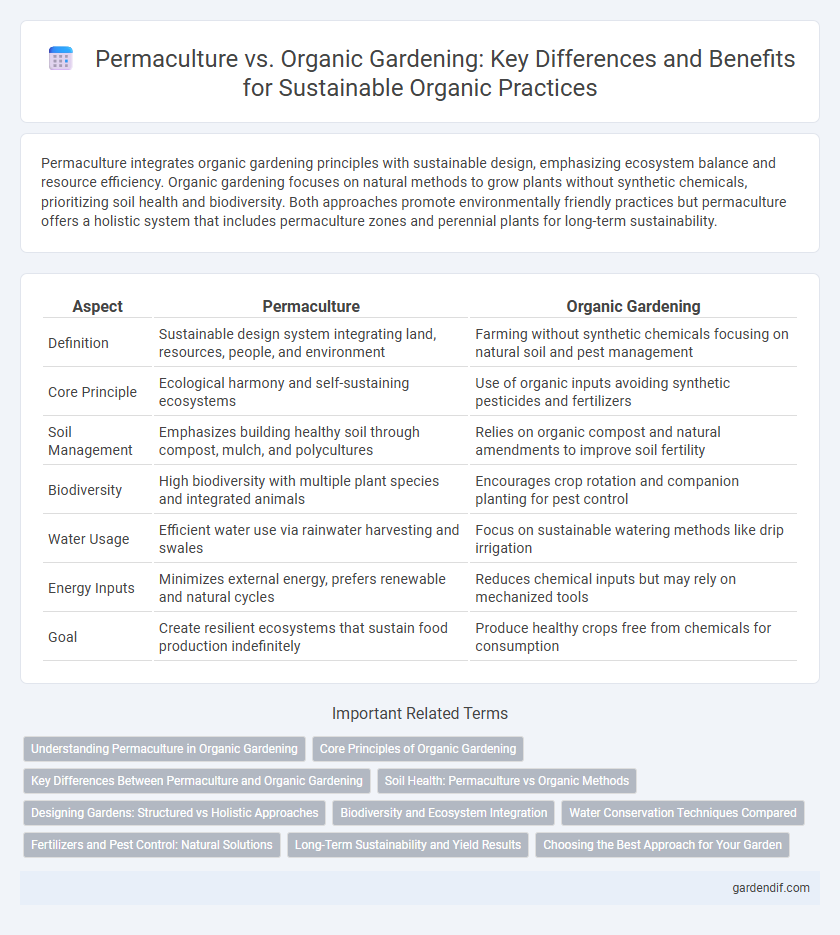
Permaculture vs Organic Gardening Illustration
Permaculture integrates organic gardening principles with sustainable design, emphasizing ecosystem balance and resource efficiency. Organic gardening focuses on natural methods to grow plants without synthetic chemicals, prioritizing soil health and biodiversity. Both approaches promote environmentally friendly practices but permaculture offers a holistic system that includes permaculture zones and perennial plants for long-term sustainability.
Table of Comparison
| Aspect | Permaculture | Organic Gardening |
|---|---|---|
| Definition | Sustainable design system integrating land, resources, people, and environment | Farming without synthetic chemicals focusing on natural soil and pest management |
| Core Principle | Ecological harmony and self-sustaining ecosystems | Use of organic inputs avoiding synthetic pesticides and fertilizers |
| Soil Management | Emphasizes building healthy soil through compost, mulch, and polycultures | Relies on organic compost and natural amendments to improve soil fertility |
| Biodiversity | High biodiversity with multiple plant species and integrated animals | Encourages crop rotation and companion planting for pest control |
| Water Usage | Efficient water use via rainwater harvesting and swales | Focus on sustainable watering methods like drip irrigation |
| Energy Inputs | Minimizes external energy, prefers renewable and natural cycles | Reduces chemical inputs but may rely on mechanized tools |
| Goal | Create resilient ecosystems that sustain food production indefinitely | Produce healthy crops free from chemicals for consumption |
Understanding Permaculture in Organic Gardening
Permaculture in organic gardening emphasizes designing self-sustaining ecosystems that mimic natural processes, enhancing soil health and biodiversity without synthetic inputs. It integrates diverse plants, animals, and water management techniques to create resilient, productive gardens that support ecological balance. This approach goes beyond traditional organic gardening by fostering long-term sustainability through closed-loop systems and habitat restoration.
Core Principles of Organic Gardening
Organic gardening emphasizes natural soil fertility through composting, crop rotation, and the avoidance of synthetic chemicals to promote healthy plant growth. It prioritizes biodiversity and ecosystem balance by encouraging beneficial insects and microorganisms. Soil health management and sustainable resource use are core principles that differentiate organic gardening from other sustainable practices like permaculture.
Key Differences Between Permaculture and Organic Gardening
Permaculture emphasizes designing self-sustaining ecosystems by integrating plants, animals, and natural cycles, while organic gardening primarily focuses on chemical-free cultivation of plants and soil health. Permaculture incorporates principles like diversity, resilience, and energy efficiency, contrasting with organic gardening's primary goal of avoiding synthetic inputs such as pesticides and fertilizers. Key differences include permaculture's holistic approach to land use and long-term sustainability versus organic gardening's emphasis on crop purity and soil enrichment techniques.
Soil Health: Permaculture vs Organic Methods
Permaculture emphasizes creating self-sustaining ecosystems by integrating diverse plants and animals, enhancing soil structure and nutrient cycling naturally. Organic gardening relies on avoiding synthetic chemicals and uses compost, cover crops, and organic fertilizers to improve soil fertility and microbial activity. Both approaches prioritize soil health, but permaculture's holistic design promotes long-term resilience and biodiversity more effectively than traditional organic methods.
Designing Gardens: Structured vs Holistic Approaches
Permaculture employs a holistic design approach that integrates natural ecosystems, emphasizing diverse plant species, water conservation, and sustainable resource cycles to create resilient gardens. Organic gardening focuses on structured methods, relying on soil health, natural fertilizers, and pest control to cultivate plants without synthetic chemicals. Both practices prioritize environmental health, but permaculture's systemic perspective contrasts with the more segmented, maintenance-driven strategies of organic gardening.
Biodiversity and Ecosystem Integration
Permaculture emphasizes designing self-sustaining ecosystems by integrating diverse plant species and natural habitats, which enhances biodiversity and supports robust ecosystem functions. Organic gardening focuses on natural soil management and avoiding synthetic chemicals but may rely more on individual plant care rather than system-wide biodiversity. The holistic approach of permaculture promotes long-term ecological balance through interconnected plant and animal communities, surpassing the biodiversity benefits of traditional organic gardening methods.
Water Conservation Techniques Compared
Permaculture employs integrated water conservation techniques such as swales, rain gardens, and keyline design to maximize water retention and reduce runoff, creating a self-sustaining ecosystem. Organic gardening focuses on mulching, drip irrigation, and soil enrichment to maintain moisture levels and minimize water waste, enhancing soil health and plant resilience. Both methods prioritize sustainable water use but permaculture offers a more holistic, landscape-level approach to water management.
Fertilizers and Pest Control: Natural Solutions
Permaculture and organic gardening both emphasize natural fertilizers like compost, manure, and green manure, promoting soil health through nutrient cycling and microbial activity. Pest control in permaculture relies on creating diverse ecosystems that attract beneficial insects and use companion planting to deter pests, minimizing the need for interventions. Organic gardening utilizes approved botanical pesticides and natural predators, maintaining ecological balance while avoiding synthetic chemicals.
Long-Term Sustainability and Yield Results
Permaculture emphasizes designing self-sustaining ecosystems that enhance soil health, biodiversity, and water conservation, leading to resilient gardens with consistent long-term yield. Organic gardening focuses on avoiding synthetic chemicals and fertilizers, promoting soil fertility through natural inputs, which can boost short-term productivity but may require more frequent intervention. Integrating permaculture principles within organic gardening can maximize sustainability and optimize yields over time by fostering natural cycles and reducing external inputs.
Choosing the Best Approach for Your Garden
Permaculture emphasizes creating a self-sustaining ecosystem by mimicking natural processes, integrating plants, animals, and soil health for long-term resilience. Organic gardening focuses on avoiding synthetic chemicals, using natural fertilizers and pest control to maintain soil fertility and plant health. Selecting the best approach depends on your garden's size, goals, and willingness to invest time into ecosystem design versus simpler organic maintenance practices.
Permaculture vs Organic Gardening Infographic

 gardendif.com
gardendif.com